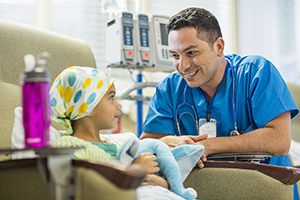Treating Cancer in Children: Chemotherapy
Treating Cancer in Children: Chemotherapy

Goals of chemotherapy
Chemotherapy is used to:
Destroy cancer cells or stop cancer cells from growing and dividing
Cause remission (no evidence of the disease on medical testing)
Cure cancer (no evidence of the disease years after treatment)
How chemotherapy works
Chemotherapy uses medicine to kill cancer cells. But it also affects healthy cells, especially ones that grow fast. This includes cells in the mouth, blood, skin, and hair. This is why side effects, such as hair loss, occur. Chemo is given in cycles. After a treatment cycle ends, time is set aside so that normal cells can recover before the next cycle begins.
How chemotherapy medicines are given
Intravenous (IV) line. A small tube called an IV is placed into a vein in the arm or another part of the body to give chemo medicines. Sometimes, a long-term IV is surgically placed in the body. This is called a central venous line or "central line". It allows medicines and other treatments to be given without having to place a new IV each time. IVs are the most common way chemo medicines are given.
Pills or liquid. The medicines are taken by mouth and swallowed.
Injection. The medicines are injected into a muscle in the arm or leg, or in the skin over a fatty part of the belly.
Intrathecal. The medicines are injected into the lower part of the spine. This is called a lumbar puncture (spinal tap). The medicine goes directly into the spinal fluid. This way of giving chemo is important because certain cancers grow in the spinal fluid.
Your child may be given chemo in the hospital, at a clinic or at home. He or she may be given more than one medicine at a time. This is called combination chemotherapy. It’s stronger and may be more effective at killing cancer cells.
Side effects of chemotherapy
Side effects occur when normal cells are affected by chemo. Most side effects are short-term and go away soon after treatment ends. But others may be long-term and permanent. Or, they may occur months or even years after treatment. Each chemo medicine can have its own side effects. Ask your child’s healthcare provider what side effects your child may have. It’s not likely that your child will have every side effect. But, he or she may have some of the following:
Short-term side effects
These effects can occur during the treatment period:
Increased risk of infection
Bleeding
Anemia (a condition that occurs when the blood doesn’t have enough red blood cells to carry oxygen throughout the body)
Hair loss
Mood changes
Dizziness
Trouble concentrating
Tiredness (fatigue)
Clumsiness
Achy muscles
Sores in the mouth or gut
Stomach pain
Nausea and vomiting
Constipation
Allergic reaction, such as hives or itching
Long-term side effects
These are effects that may appear months to years after treatment:
Infertility
Damage to certain organs, such as the heart, kidneys, liver, or lungs
Nerve damage that lasts
Another cancer that occurs at a later time
Treatment and testing
Your child will likely be given medicine to treat the short-term side effects of chemo. This may include medicines to ease nausea, vomiting, constipation, and pain. The healthcare team will also teach you how you can help manage your child’s side effects. Also, your child may have tests done to check for possible long-term side effects, such as organ damage. Talk with your child’s healthcare provider about this.
Call your child’s healthcare provider
Call your child’s healthcare provider right away if your child has any of the following:
Chest pain (call 911)
Trouble breathing (call 911)
Temperature of 100.4°F (38°C) or higher, or as directed by the healthcare provider
Chills
Headaches or changes in vision
Dizziness or lightheadedness
Confusion
Trouble concentrating
Ongoing fatigue
Weakness in the hands or feet
Clumsiness
Pain that doesn’t go away, especially if it’s always in the same place
A new or unusual lump, bump, or swelling
Uncontrolled nausea and vomiting
Diarrhea that doesn’t improve over time
Constipation
Weight loss
Dehydration
Unusual rashes, bruises, or bleeding
Skin breakdown or significant pain due to skin irritation
Cancer resources
To learn more and find support check out these resources:
American Cancer Society
800-227-2345
www.cancer.orgNational Cancer Institute
800-422-6237
www.cancer.govCancerNet
www.cancer.netChildren's Oncology Group
www.childrensoncologygroup.org
Updated:
June 28, 2018
Sources:
Fever and Neutropenia in Pediatric Patients with Cancer. Meckler, G .Emergency Medicine Clinics of North America. 2009, is. 27, pp. s525-44.
Reviewed By:
Levy, Adam S., MD,Sather, Rita, RN